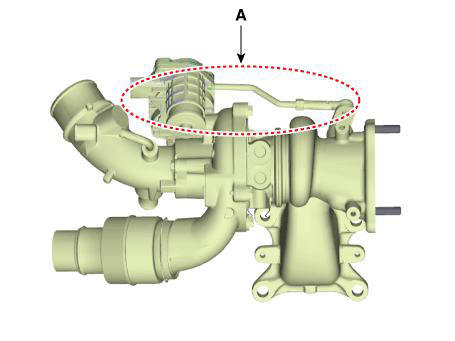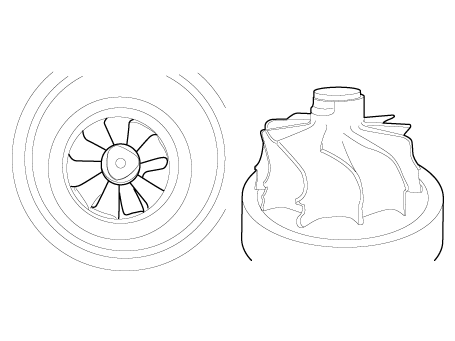Hyundai Tucson: Intake And Exhaust System
Removal and Installation
- Remove the Turbocharger & Exhaust Manifold.
(Refer to Intake And Exhaust System - "Exhaust Manifold")
On-vehicle Inspection
Turbocharger Diagnostic Flow

If any problem related with turbocharger, such as lack of engine power, poor acceleration, abnormal engine noise or oil leaks, may occur, check the turbocharger according to the procedure as follows.
- Check the assembly of the turbocharger and the exhaust fitting (or the after treatment).
- Check that a gasket is installed.
- Check that mounting bolts (or nuts) are tightened properly.
- Check for gas leakage.
- Check for any damage, such as crack, on the parts.
Gas leakage caused by lack of gasket or inadequately tightened mounting bolts (or nuts) may cause abnormal engine noise.
If the cause of the problem is detected, retighten the mounting bolts (or nuts) to the specified torque or replace the gasket or damaged parts with new ones if necessary.
- Check the assembly of the exhaust manifold and the cylinder head.
- Check that a gasket is installed.
- Check that the mounting bolts (or nuts) are tightened properly.
- Check for gas leakage.
Gas leakage caused by lack of gasket or inadequately tightened mounting bolts (or nuts) may cause abnormal engine noise.
If the cause of the problem is detected, retighten the mounting bolts (or nuts) to the specified torque or install a new gasket if necessary.
- Check the turbocharger oil feed pipe & hose and oil drain pipe & hose.
- Check that a gasket is installed.
- Check if the mounting bolts are tightened properly.
- Check if the clamps are positioned in place.
- Check if the oil pipes & hoses are damaged (bent, crushed, torn or cracked).
If a gas leak occur as a gasket was not installed or mounting bolts were tightened inadequately, it may cause oil leaks.
If the oil feed pipe & hose is damaged, engine oil is not supplied sufficiently to the turbocharger then it may damage the turbocharger. If the oil drain pipe & hose is damaged and clogged, engine oil is not drained smoothly then it may cause oil leaks from the turbocharger.
If the cause of the problem is detected, retighten the mounting bolts (or nuts) to the specified torque or replace the gasket or damaged parts with new ones if necessary.
- Check for oil leakage between center housing and compressor housing.
- Check that the mounting bolts are tightened properly.
- Check for oil leakage.
Damaged O-ring (gasket) between the center housing and the compressor housing may cause oil leakage.
If an oil leak is detected, replace the turbocharger with a new one.
- Inspect the rod unit of the electric waste gate actuator (EWGA).
Check that the rod setting marks (A) of the EWGA match.

Damaged turbocharger actuator may cause lack of engine power and poor acceleration.
If the actuator rod does not move, replace the turbocharger with a new one.
- Check the electric waste gate actuator (EWGA).
- Electric waste gate actuator (EWGA) : Check for movement of the actuator rod when a forced actuator operating mode is performed by diagnostic tool. (Refer to DTC guide)

If the turbocharger actuator is damaged, it may cause lack of engine power and poor acceleration.
If the actuator rod does not move, replace the turbocharger with a new one.
- Check the turbocharger compressor wheel.
- Check if the compressor wheel is damaged (bent or deformed).
- Check that the compressor wheel rotates smoothly.
e.g.

Damaged compressor wheel may cause abnormal noise from the turbocharger and poor acceleration.
If the compressor wheel are damaged or deformed, replace the turbocharger with a new one.
- Check the turbocharger turbine wheel.
- Check if the turbine wheel is damaged.
- Check that the turbine wheel rotates smoothly.

Damaged turbine wheel may cause abnormal noise from the turbocharger and poor acceleration.
If the turbine wheel are damaged or deformed, replace the turbocharger with a new one.
If no problem is detected from the turbocharger, check the turbocharger-related parts according to the procedure as follows.
- Check the blow-by hose. (Refer to FL group)
- Check if the breather hose is damaged (bent, clogged).
- Check if the positive crankcase ventilation (PCV) valve is clogged.
If the breather hose is bent or clogged, the internal pressure in the engine will increase and engine oil will not be supplied smoothly to the turbocharger, causing damage to the turbocharger and oil leakage.
If the cause of the problem is detected, replace the breather hose or the related parts with new ones.
- Check the air intake hose connected to the turbocharger.
- Check if the air intake hose is damaged (bent, crushed, detached or torn).
If the cross-section of the hose diminishes as the air intake hose is bent or crushed, intake air to the turbocharger will be reduced and the pressure in front of turbocharger will drop, causing damage to the turbocharger or oil leakage. If the air intake hose is detached or torn, foreign substances may go into the turbocharger causing damage to it.
If the air intake hose is damaged, replace it with a new one.
- Check the air cleaner.
- Check the air cleaner filter for pollution state.
- Check the air cleaner filter for water influx.
- Check the air cleaner cover for dirtiness.
- Check that the air cleaner filter is a genuine part.
If the air cleaner filter is moistened or polluted excessively or a non-genuine part is used, intake air to the turbocharger will be reduced and the pressure in front of turbocharger will drop, causing damage to the turbocharger and oil leakage.
If the air cleaner filter is moistened or polluted excessively, replace it with a new one.
WARNING
Replace the air cleaner filter according to the maintenance schedule.
- Check the intercooler hoses & pipes.
- Check that the intercooler hoses & pipes are connected properly.
- Check if the intercooler hoses & pipes are damaged (bent, detached or torn).
- Check for any damage, such as crack, on the intercooler pipes.
- Check that the clamps are positioned in place.
If the intercooler hoses & pipes are damaged or disconnected, oil leakage may occur from the hoses & pipes and the turbocharger may exceed the permissible speed causing damage to the turbocharger.
If the intercooler hoses & pipes are damaged, replace them with new ones.
WARNING
Use new clamps when replacing the hoses & pipes.
- Check the intercooler.
- Check if the intercooler tubes and tanks are damaged (oil leak or crack).
If the intercooler is damaged, the turbocharger may exceed the permissible speed causing damage to the turbocharger.
If the intercooler is damaged, replace them with a new one.
WARNING
Use new clamps when replacing the intercooler
- Check the engine oil.
- Check the engine oil level.
- Check the engine oil for discoloration, water influx and viscosity degradation.
- Check the engine oil grade.
If the engine oil level is low, amount of engine oil fed to turbocharger will be reduced causing the bearings in the turbocharger to adhere due to insufficient lubrication and cooling.
If the cause of the problem is detected, add or change engine oil.
WARNING
Change the engine oil according to the maintenance schedule.
- Check the engine oil pressure.
- Engine oil pressure: Check the oil pressure using an oil pressure gauge after removing the oil pressure switch on the cylinder block.
- Check the engine oil screen in the oil pan if the engine oil level is low. Then check the injectors for gas leakage if foreign substances are accumulated on the oil screen.
If the engine oil level is low, amount of engine oil fed to turbocharger will be reduced causing the bearings in the turbocharger to adhere due to insufficient lubrication and cooling.
If the cause of the problem is detected, add or change engine oil. If foreign substances are accumulated on the oil screen, wash the oil screen and replace the injector's washer with a new one after checking the injectors for gas leaks. Check the engine oil-related parts, such as oil pump, if necessary.
WARNING
As the turbocharger rotates at high speed of 100,000 rpm or above, deterioration of engine oil can cause damage to the turbocharger bearings. Check engine oil for discoloration, water influx, viscosity degradation and oil pressure lowering.
- Check the injectors, sensors, etc.
- Check that the injectors operate properly.
- Check that the sensors, such as the mass air flow sensor (MAFS), intake air temperature sensor (IATS), and boost pressure sensor (BPS), operate properly.
Improper operation of the injectors, sensors, EGR valve, etc. may cause diminished engine power.
If the cause of the problem is detected, replace the related parts with new ones.
READ NEXT:
 EGR cooler
EGR cooler
Components
EGR cooler
EGR cooler hose A
EGR cooler outlet hose
EGR cooler gasket
EGR valve gasket
EGR valve
Removal and
Installation
Disconnect the negative battery terminal.
Remove the engine cover.
(Refer to Engine an
 EGR cooler- Removal and Installation
EGR cooler- Removal and Installation
Disconnect the battery negative terminal.
Remove the front bumper beam.
(Refer to Body(Interior and Exterior) - "Front Bumper Beam Assembly")
Remove the intercooler mounting bracket (A), and then disconnect the
intake temperat
 Front Muffler
Front Muffler
Removal and Installation
Disconnect the battery negative terminal.
Disconnect the oxygen sensor connector (A).
Remove the engine room rear under cover (A).
Tightening torque :
7.8 - 11.8 N.m (0.8 - 1.2 kgf.m, 5.8 - 8.7 lb-ft)
SEE MORE:
 Keyless Entry And Burglar Alarm
Keyless Entry And Burglar Alarm
Description
Burglar Alarm State (B/A State)
Remark: On Smart key system, it works the same way with passive lock
Remark: On Smart key system, it works the same way with passive unlock
Remark: On Smart key system, it works
 Head Lamp Aiming
Head Lamp Aiming
Instructions
Alternately turn the adjusting gear to adjust the head lamp aiming.
If beam-setting equipment is not available, proceed as follows:
Draw vertical lines (Vertical lines passing through respective head lamp
centers) and a horizo
Information
- Home
- Hyundai Tucson - Fourth generation (NX4) - (2020-2023) - Owner's Manual
- Hyundai Tucson - Fourth generation (NX4) - (2020-2023) - Workshop Manual